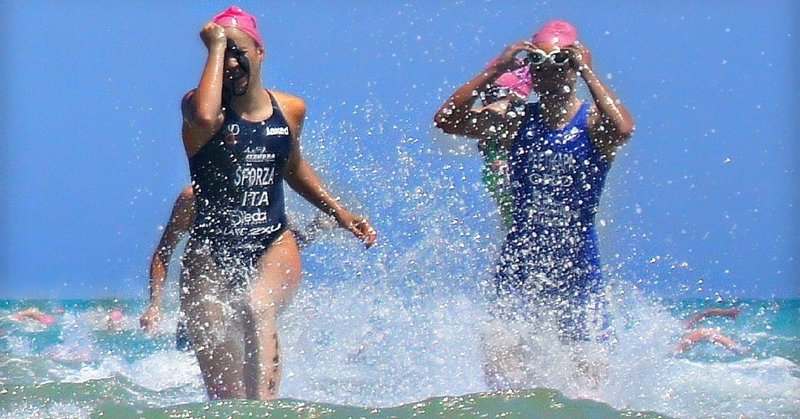
オリンピックディスタンストライアスロン競技のバイクトレーニング再考
2019年のトライアスロンシーズンも開幕し既にヒートアップしている状況ではありますが、今年は2020年東京オリンピックの前年ということもあり更なる熱戦が繰り広げられるのではないかと推測されます。
そこで、という訳ではありませんが、オリンピックディスタンストライアスロン競技のバイクトレーニングに関して様々な示唆を与えてくれている先行研究がありましたので、以下にご紹介したいと思います。
Med Sci Sports Exerc. 2009 Jun;41(6):1296-302.
Distribution of power output during the cycling stage of a Triathlon World Cup.
Bernard T,Hausswirth C,Le Meur Y,Bignet F, Dorel S,Brisswalter J
Abstract
PURPOSE:
The aim of this study was to evaluate the power output (PO) during the cycle phase of the Beijing World Cup test event of the Olympic triathlon in China 2008.
METHODS:
Ten elite triathletes (5 females, 5 males) performed two laboratory tests: an incremental cycling test during which PO, HR at ventilatory thresholds (VT1 and VT2), and maximal aerobic power (MAP) were assessed, and a brief all-out test to determine maximal anaerobic power output (MAnP). During the cycle part of competition, PO and HR were measured directly with portable device. The amount of time spent below PO at VT1 (zone 1), between PO at VT1 and VT2 (zone 2), between PO at VT2 and MAP (zone 3) and above MAP (zone 4) was analyzed.
RESULTS:
A significant decrease in PO, speed, and HR values was observed during the race. The distribution of time was 51 +/- 9% for zone 1, 17 +/- 6% for zone 2, 15 +/- 3% for zone 3, and 17 +/- 6% was performed at workloads higher than MAP (zone 4). From HR values, the triathletes spent 27 +/- 12% in zone 1, 26 +/- 8% in zone 2, and 48 +/- 14% above VT2.
CONCLUSIONS:
This study indicates a progressive reduction in speed, PO, and HR, coupled with an increase in variability during the event. The Olympic distance triathlon requires a higher aerobic and anaerobic involvement than constant-workload cycling exercises classically analyzed in laboratory settings (i.e., time trial) or Ironman triathlons. Furthermore, monitoring direct PO could be more suitable to quantify the intensity of a race with pacing strategies than classic HR measurements.
この論文は、オリンピックディスタンストライアスロン競技のバイクパートにおけるペダリング動作のパワーアウトプット等のパラメータを測定したものですが、着目すべき点は著者らが"The Olympic distance triathlon requires a higher aerobic and anaerobic involvement than constant-workload cycling exercises classically analyzed in laboratory settings (i.e., time trial) or Ironman triathlons. "と結論付けている点です。
すなわち、オリンピックディスタンストライアスロン競技(のバイクパート)においては、アイアンマンディスタンストライアスロン競技より無気的能力が必要とされるということです。
●オリンピックディスタンストライアスリートの優劣に関与するのは無気的能力
トライアスロン競技は持久系競技であることに疑いの余地はありませんが、近年のオリンピックディスタンストライアスロン競技の記録は2時間を大きく下回る程、高速化していることから考えれば有気的能力が重要であることは勿論、むしろ有気的能力よりも無気的能力が重要であると考えられ、特にバイクパフォーマンスに関しては無気的能力の高さがより大きく関与していることが推察されます。
なぜなら、スイム能力に劣る選手はバイク序盤に前方の集団に追いつくために一気にペースを上げなければなりませんし、また、折り返しターンのあるバイクコース(以下の動画1:03辺り参照)では折り返し後に集団から離れないよう一時的なスプリントが必要になり、周回コースになれば、そのスプリントを定期的に複数回繰り返さなければならないことから高い無気的能力が必要になるといえるからです。
そして、オリンピックディスタンストライアスロン競技において、無気的能力の高さはバイク後に引き続き行われるランのパフォーマンスに影響を及ぼす可能性があります。
高い無気的能力を有することは上述したような状況下のバイクパートにおける疲労の軽減をもたらし、その後のランパフォーマンスに結び付くといえるからです。
従って、オリンピックディスタンストライアスリートのバイクトレーニングはVO2maxを超える強度でのインタバールトレーニングを重視する必要があると共にペダリング動作による下肢の筋疲労を抑える上では高い筋力を有することでぺダリング動作に余裕を生み出すことも重要であるといえることからウエイトトレーニングに取り組む必要があるといえるでしょう。
●世界との差を埋めるべく
現在のオリンピックディスタンストライアスロン競技においてはスイムとランが、より重視されている傾向があり、JTU(日本トライアスロン連合)でもスイムとランの認定記録会を行っていますが、世界レベルで戦う上では無気的能力を中心とするバイクパフォーマンスの高さこそが最も重要であり、バイクの能力評価も重要であると考えられます。
更にいえば、この無気的能力を中心とするバイクパフォーマンスの差こそが現在の日本と世界との差ではないかと推察され、そのような点で、無気的能力を含むバイク能力の評価方法の確立及びその評価、更に、その評価に基づくバイクトレーニングの徹底が世界との差を埋めるために必要不可欠になるのではないでしょうか!?
●追記:バイク能力の評価として
近年、サイクリストやトライアスリートの間で注目されているFTP(Functional Threshold Power)という概念、指標は書籍「Training and Racing with a Power Meter」の中で、その著者Andrew Coggan(PhD)によって提唱された概念、指標であり「1時間のぺダリング運動において持続可能な最大出力」と定義されていますが、以下の先行研究によれば8分間最大出力テストによって推定されたFTP(8分間最大出力テストで得られた平均出力(W)×0.90)はOBLA(Onset Blood Lactate Accumulation=血中乳酸蓄積開始点=血中乳酸濃度が4mmol/lに相当する運動強度)でのパワーアウトプット(Power Output@OBLA)と同等であることが示されています。
J Strength Cond Res. 2012 Feb;26(2):416-21.
Comparison of a field-based test to estimate functional threshold power and power output at lactate threshold.
Gavin TP, Van Meter JB, Brophy PM, Dubis GS, Potts KN, Hickner RC.
Abstract
It has been proposed that field-based tests (FT) used to estimate functional threshold power (FTP) result in power output (PO) equivalent to PO at lactate threshold (LT). However, anecdotal evidence from regional cycling teams tested for LT in our laboratory suggested that PO at LT underestimated FTP. It was hypothesized that estimated FTP is not equivalent to PO at LT. The LT and estimated FTP were measured in 7 trained male competitive cyclists (VO2max = 65.3 ± 1.6 ml O2·kg(-1)·min(-1)). The FTP was estimated from an 8-minute FT and compared with PO at LT using 2 methods; LT(Δ1), a 1 mmol·L(-1) or greater rise in blood lactate in response to an increase in workload and LT(4.0), blood lactate of 4.0 mmol·L(-1). The estimated FTP was equivalent to PO at LT(4.0) and greater than PO at LT(Δ1). VO2max explained 93% of the variance in individual PO during the 8-minute FT. When the 8-minute FT PO was expressed relative to maximal PO from the VO2max test (individual exercise performance), VO2max explained 64% of the variance in individual exercise performance. The PO at LT was not related to 8-minute FT PO. In conclusion, FTP estimated from an 8-minute FT is equivalent to PO at LT if LT(4.0) is used but is not equivalent for all methods of LT determination including LT(Δ1).
OBLAの生理学的意義は不明瞭な点もありますが、OBLAは無気的エネルギー供給システムの関与も大きい運動強度であるといえることから、上述したオリンピックディスタンストライアスリートの無気的能力を中心とするバイクパフォーマンス(バイク能力)を評価する上でPower Output@OBLA=FTPを用いることが有効であることが推察されます。
今後、FTPを用いたバイク能力の評価方法を確立するために、FTPを推定する上で8分間テストを用いた方が有効なのか、20分間テスト(20分間最大出力テストで得られた平均出力(W)×0.95)を用いた方が有効なのかを検証すべく更なる研究が必要であると共にFTPとオリピックディスタンストライアスロン競技パフォーマンス及びバイクパートパフォーマンスとの関係に関する更なる研究が必要であるといえるでしょう。
また、ペダリング運動のパワー出力は「トルク(簡単にいえばペダルに加わる回転力)xケイデンス(回転数)」で表されることからハイケイデンス(高回転数)で得られたFTPとローケイデンス(低回転数)で得られたFTPは同じ値でも、その解釈、評価は異なる可能性があり、トライアスロン競技においてはハイケイデンスによるパワー出力が重要であると考えられることから、ケイデンスを設定(例えば、90rpm)したFTPの測定、評価が重要であるといえるかもしれません。
FTPならびにケイデンスに関しては以下の記事も参照下さい。
よろしければサポートをお願いします! いただいたサポートはクリエーターとしての活動費に使わせて頂きます!!
